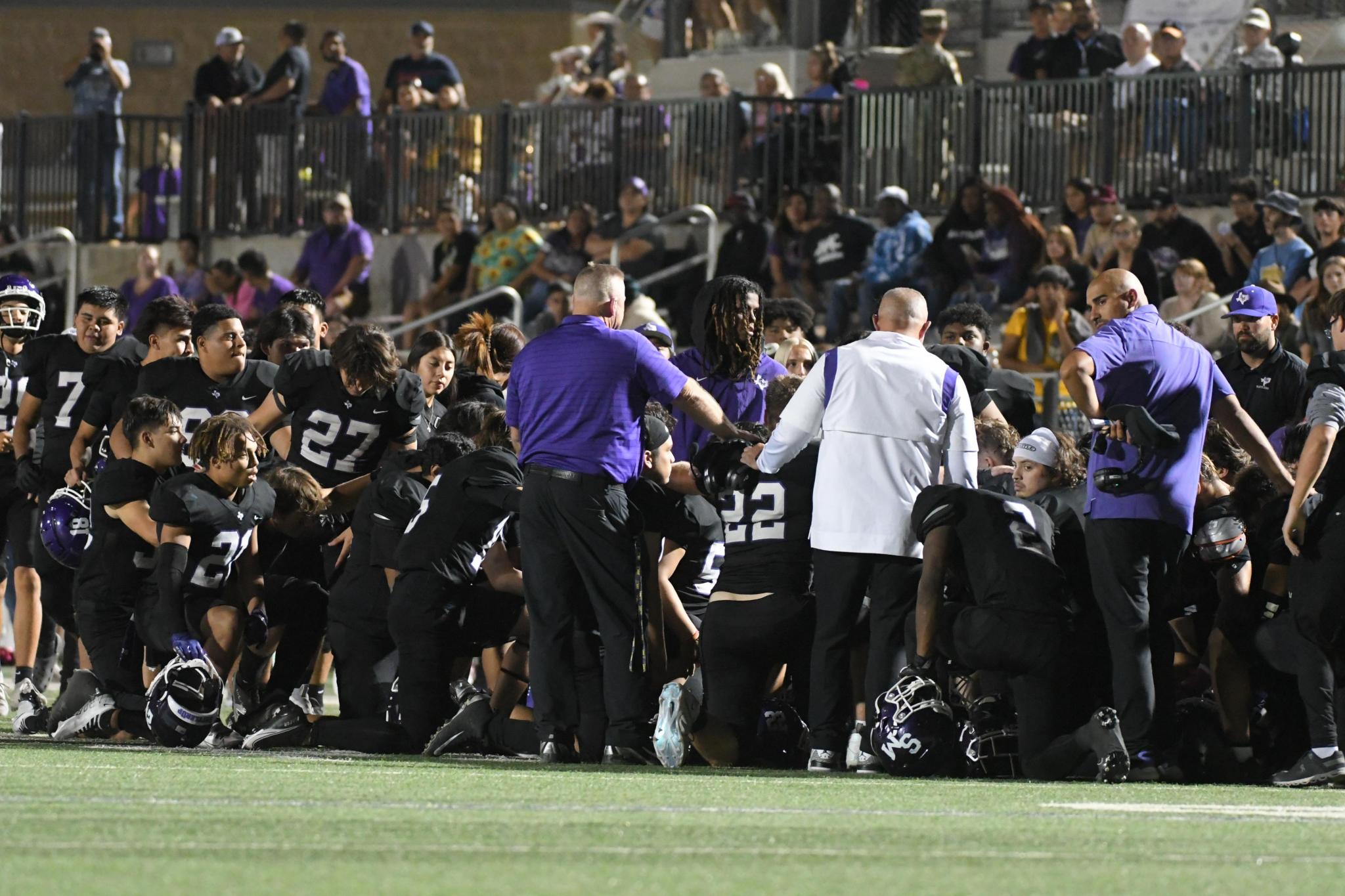
The importance of responding to automated external defibrillators has drawn new attention after Buffalo Bills safety Damar Hamlin went into cardiac arrest on Monday. Above, San Marcos’ football gathers to pray following an injury during the 2022 season. Daily Record photo by Gerald Castillo
Importance of AEDs comes into focus in wake of Hamlin cardiac arrest
After Buffalo Bills safety Damar Hamlin went into cardiac arrest during Monday’s NFL game against Cincinnati, conversations have once again started regarding the importance of responding to situations like the one just witnessed where a player suffers a cardiac arrest.
Being a head coach for 17 years, San Marcos Athletic Director and Head Football Coach John Walsh knows that better than anyone else.
“Anytime you are involved with athletics, the body is going to expend a lot of energy,” Walsh said. “We put our bodies through a lot of trauma whether it is getting tired or being hot or cold. You never know how the body is going to react. As professionals, we have to be ready for the worst-case scenario. An AED or CPR will save your life and you hope you never have to use it but you need to be prepared when that time comes.”
An AED, Automated External Defibrillator, is used for situations where a player suffers a cardiac arrest in the middle of a game.
AEDs are extremely important for Head Athletic Trainer Janna Roper as the device gives a patient much-needed time before emergency services can arrive.
“With an AED, it gives a little bit of time,” Roper said. “If there is a cardiac incident, it can take awhile depending where you are at for the EMS or the paramedics to get there so the AED can give you a little bit of time for them to get there once you started CPR. It is really important because the AED acts as a defibrillator until someone comes.”
Because of the critical use of the AEDs, San Marcos Consolidated ISD has multiple devices spread out across multiple locations with the high schools using as many as five.
“Our high school campus is equipped with four AEDs,” Roper said. “One is located at the football stadium, one at our baseball and softball facilities, one that is centrally located at our gym, and the other at our track and field complex on top of having an extra one when traveling with the cross country team.”
While the athletic trainers must know how to use and perform the AED and CPR, coaches are also expected to perform these duties as well.
“It’s just as important for the coaches to know what to do just as well as our trainers do,” Roper said. “We want our coaches to be as comfortable using the AED or performing CPR just like how trainers do.”
Much of the credit goes to SMCISD Superintendent Dr. Michael Cardona who has made it a mission to make sure students will be taken care of in case of an emergency, Walsh said.
“When I got here, Dr. Cardona as pro taking care of the kids any way possible,” Walsh said. “We don’t lack off here in providing AEDs or training. San Marcos has more AEDs than I have seen anywhere on campus. You are not going to walk far without running into one on campus from K-12.”
“Anytime you witness a scenario like what happened on Monday night, people are going to be more aware,” Walsh said. “We are happy that we work in a district where we have the resources to be ready for a situation like this.”
In fact, SMCISD had an incident where a Miller Middle School soccer player went into cardiac arrest during a game in 2016.
Brittney Webb, a former San Marcos athletic trainer and now Athletic Training Division senior lecturer at Texas State University as part of the Health and Human Performance Center, was there when the incident happened.
“During the game, one of our kids looked like he grabbed his shoulder and went knees down before going face down,” Webb said. “I went running out there and he was unresponsive. I knew it was a dire situation so I told the coach to grab the AED and told the police officer to call 911. We started CPR and got the AED there where he was shocked twice. He came back by the time the EMS and the firefighters showed up. He was then taken to Dell’s Children Hospital and made a full recovery.”
Because of the unpredictable occurrences of when a cardiac arrest happens to an athlete, Webb, who is also on the Texas Advisory Board of Athletic Trainers, knows about being prepared when emergency situations like this happen.
“These types of scenarios do come out of nowhere,” Webb said. “This particular athlete had a heart complication that nobody knew about but as an athletic trainer, your training and skill set that you have takes over and that is what you practice over and over again, go over the action plans every semester and have the police and paramedics on board when this does happen. Athletic Trainers are prepared to deal with these and our instincts kick in but you have to give the glory to god for having the athletic trainers there and being able to execute the plan.”
In the end, it all comes down to not only knowing the plan but also executing the plan as well.
“It’s extremely important to know who is on that medical team when that goes down,” Webb said. “Everybody has to know their own role and it should be rehearsed every semester for all sports. That is what makes situations go right without a hitch because minutes and seconds are life and death.”











